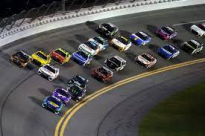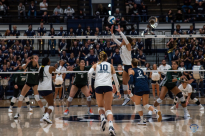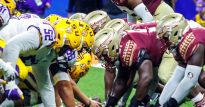2016 NFL Combine Recap: Offensive Prospects
QUARTERBACKS
Two names stand alone at the top of the quarterback draft boards, but there is depth in this year’s class. Teams will use mid-round picks on players who will need a year or two of seasoning, but also have the physical ability to succeed at the next level.
Here is a look at how the top quarterback prospects fared at the 2016 NFL Combine:
Jared Goff, California
Goff is widely regarded as a lock to be a top ten pick, and he did nothing on Saturday to diminish those thoughts. Goff has the size, measuring at 6 feet 4 inches and 215 pounds. One issue for Goff is his hand size – only nine inches. Yet, it was important for scouts to see Goff reach the nine-inch mark; Ryan Tannehill, Derek Carr and Colin Kaepernick all have similar hand sizes.
The former Golden Bear built his stock up by making all the throws and showed the ability to throw short, intermediate, and deep passes accurately. According to Bleacher Report’s Matt Miller, Goff has the touch and timing to succeed in the NFL.
Carson Wentz, North Dakota State
Wentz did everything right on Saturday with an impressive showing. The other candidate to be the first quarterback chosen off the board, Wentz displayed great accuracy throwing the deep ball and had a decent 40-time, clocking in at 4.77. Wentz’s timing in the pocket and delivering balls on time was also impressive. He supposedly possesses a stronger arm than Goff’s. The difference-maker: Wentz is 6-foot-6, 231 pounds.
The knock on Wentz is the small-school stigma. How he will fare against NFL talent after playing mediocre teams in college remains a question mark. In addition, Goff was the more accurate quarterback in the throwing portion of the combine.
Paxton Lynch, Memphis
Lynch did an OK job at the combine. He displayed why scouts have graded him out as a first-round pick. He also showed why he would take some developing before he can start in the NFL. Lynch has a big arm and is extremely mobile despite his 6-foot-6, 225-pound frame. His throwing drills were not quite as smooth as Goff or Wentz. Another potential problem for Lynch’s draft stock is his health. The health of his AC joint in his throwing shoulder along with both of his knees raised red flags from teams’ medical staffs.
Lynch struggled with his footwork, oftentimes looking a little stiff dropping back from under center. The offense he ran while at Memphis did not stress taking snaps from under center. If Lynch can stay healthy and improve his accuracy and footwork, he has the physical skills to become a solid quarterback on Sundays.
Christian Hackenberg, Penn State
Hackenberg had the worst combine out of any of the top quarterbacks. That is not to say he cannot be a valuable asset to a franchise in need of a quarterback. Still, Hackenberg missed some easy throws and had poor body language when he made mistakes during throwing drills. The former Nittany Lion measured in at 6-foot-4, 223 pounds and, like Goff, had 9-inch hands.
Hackenberg is built like a prototypical NFL quarterback and has the arm strength to make deep throws. He is likely a day two, developmental type quarterback with the arm talent needed to succeed, but must learn to make better decisions with the football.
Dak Prescott, Mississippi State
Prescott has been tearing up the offseason showcases, earning Most Outstanding Player at the Senior Bowl. At the combine, he continued to impress. His footwork was excellent, and he delivered the ball quickly out of the pocket. He was once known as a running-first quarterback, but has improved his field vision and in turn, has become a better passer.
Still, Prescott has a lot of work to do to become a better passer overall. Sometimes, he still throws sidearm and must gain more experience reading the field. Look for Prescott to be taken in the later rounds with a chance to compete for a backup spot.
Jeff Driskel, Louisiana Tech
Driskel’s career has been up and down, but recently, he has been making waves among scouts and talent evaluators. Driskel, once a highly touted prospect with the Florida Gators, transferred to La. Tech after struggling in Gainesville. Now he is tearing through the pre-draft workouts.
Driskel clocked in as the fastest quarterback at the combine, running a blistering 4.56 40-yard dash. He also had the best broad jump at 122 inches. Size, arm strength and athleticism are not issues for Driskel. The issue is that he played in a shotgun-heavy scheme in Louisiana, whereas he struggled under center for the Gators. But after a solid offseason, he is ranking as high as a second-round grade, though he could fall to the middle rounds.
Connor Cook, Michigan State
Connor Cook is not lacking in confidence. He compared himself to Tom Brady multiple times at the scouting combine in terms of his leadership and ability to let mistakes go. Cook was solid in every drill, but according to Sports Illustrated’s Doug Farrar, Cook was worse than advertised at short to intermediate throws. Cook appears to be safely in the second-round conversation
RUNNING BACKS
Running backs are hardly ever at the center of the festivities come Draft Day, the newest group of prospects has undeniable promise in a position group that hasn’t seen a first overall pick sent their way since 1995. Heisman Trophy winner Derrick Henry and Big Ten Offensive Player of the Year Ezekiel Elliott lead this group of young studs looking to leave a lasting impact on the league.
Here are some of the prospects that increased and decreased their draft stock on Friday:
Derrick Henry, Alabama
Who doesn’t want to be this guy right now? After joining fellow running back Mark Ingram as the only Crimson Tide players to take home college football’s most prestigious award, he led his team to their fourth national championship in seven years. He registered a very impressive 40-yard dash time at 4.54 seconds and also ranked second in the broad jump at 10’10.
Concerns still remain about his agility and change of direction, but at 6’3, 247 pounds, his bruising style will be more than enough to draw eyes from NFL scouts.
Ezekiel Elliot, Ohio State
Considered by many to be the best running back in the class, Elliott only added to his draft stock at the combine, posting a 4.47 40-yard dash to go along with his superior size at 6’0, 225 pounds.
Elliott’s quick reaction time and instincts are sure to be an asset to whichever team decides to take him, and his explosiveness gives him potential to break out a game-changing long run at any time.
Kenyan Drake, Alabama
Drake may not have the prototypical NFL running back build - 40 pounds lighter than his Alabama teammate Henry - but his 4.45 40-yard dash time proves his versatility and ability to break out big plays. He is seen more as a pass-catching back, not having the size to bang around with the hogs at the line of scrimmage, but in today’s fast paced offensive league, that is a valuable skill to have.
Injuries in 2014 and 2015 may be a red flag for teams looking at Drake concerns also rest with his workload and stamina after playing behind Henry.
Keith Marshall, Georgia
The Bulldogs have churned out running backs such as Knowshon Moreno and Todd Gurley in recent years, and Marshall may be the next big thing. His 4.31 40-yard dash time was the fastest at the entire combine and third-best in the last 10 years.
Like Drake, Marshall has had to battle multiple injuries as well as a horrible offense in the past three seasons but if he can rekindle his explosiveness from his freshman season, he could be a real sleeper pick.
Devontae Booker, Utah
Booker’s pure size and athleticism made him a hard man to bring down in the Pac-12, but scouts are concerned with his speed, worried that he will be easy prey for pursuing defenders at the next level.
Booker’s pass protection leaves some doubts as well, but his natural instincts and raw power make him a very intriguing prospect.
C.J. Prosise, Notre Dame
Size is not the issue for Prosise, weighing in at 220 pounds with an every-down back build. He can flash out as a receiver as well, leading Notre Dame in yards per reception last year at 17.8.
Concerns lie in his instinct and pass protection, labeling him unable to pass protect or properly read a zone defense, which may limit his playing time early in his career.
Daniel Lasco, California
Not the most heralded of backs coming into the combine, the Pac-12 honorable mention impressed scouts with his 4.46 40-yard dash and 41.5 inch vertical. His lack of creativity and inability to push for the extra yard continue to be issues for Lasco, but he could be solid in a pass-catching role out of the backfield.
A possibility for Lasco is as a special teams contributor, as he tallied 12 special teams tackles in his freshman year in Berkeley.
WIDE RECEIVERS
Unlike in years past, the 2016 wide receiver class isn’t as deep as we’re used to. Only one wide receiver is projected to be drafted in the top 15 and at most, two will be drafted in the first round. This year has proven to be a very defensive heavy class, meaning many productive receivers will see draft day falls into the late day two, early day three selections.
The group also failed to show off their speed. NFL Network’s Mike Mayock said it was the slowest class he had ever seen. Iowa kicker Marshall Koehn ran a 4.61, which was faster than 11 of the wide receivers.
After working out at the NFL Combine in Indianapolis on Saturday, let’s take a look at which wide receiver prospects helped and hurt their draft stock.
Laquon Treadwell, Ole Miss
Despite not running the 40 yard dash, Laquon Treadwell had a strong combine performance. Widely considered the number one wide receiver prospect this year, Treadwell showed how well his ball skills are in the position drills. His route tree still needs to grow a couple branches, but his overall talent is too good to pass up.
With strong hands and an decent footwork in the wide receiver drills, Treadwell solidified his top 15 pick draft stock and remains possibly the only wide receiver to be taken in the first round.
Will Fuller, Notre Dame
Will Fuller out of Notre Dame easily had the best showing out of any of the receivers on Saturday. He ran a 4.33 40 yard dash, the best among his position and also performed well in the shuttle runs.
His superior route running was put on display in Indianapolis and he did everything NFL executives are looking for in a prospect. While I question Fuller’s body catching tendencies, he’s most likely a late second round pick. Teams will be excited to mold him into an elite NFL receiver with that kind of speed.
De’Runnya Wilson, Mississippi St.
De’Runnya Wilson’s draft stock took a major blow this weekend. He ran the worst 40 yard dash among wide receivers (4.90), the worst vertical jump (28 in), and the third worst broad jump (113 in).
A mid round prospect out of Mississippi State, Wilson may have just dropped himself into the sixth round with his performance. His lack of separation skills already troubled draft evaluators, but this performance may do him in for some teams.
Josh Doctson, TCU
Put Josh Doctson in the win column for the combine. He ran a respectable 4.51, had the best vertical leap at 41 inches, the second best broad jump at 131 inches, the second best 20-yard shuttle, and the third best 60-yard shuttle.
He was a workout warrior on Saturday and definitely put himself into late first round contention. While I expected him to run a bit faster, it seems this entire wide receiver class is slower than years past.
D’haquille “Duke” Williams, Auburn
With personality questions looming after being dismissed from Auburn, D’haquille Williams had to wow scouts at the NFL Combine. Unfortunately, he did the complete opposite. He ran a 4.73 40 yard dash (second worst at his position), had a 30 inch vertical (third worst), a 7.43 three-cone (worst), and a 4.47 20-yard shuttle (second worst).
Despite throwing up big numbers at Auburn, William’s lack of athleticism and questionable character may lead to him going undrafted. At his press conference, Williams said "I'm a first-round pick no matter what, but off the field I'm a seventh-round pick". That is the opposite of what NFL teams want to hear from a player.
TIGHT ENDS
This year’s NFL draft isn’t filled with tight ends ready to make an immediate impact in the NFL. The tight end position is hard to make an impact in the NFL right away and this isn’t exactly what we would call a deep tight end class.
Here are some guys that increased or decreased their draft stock at the 2016 NFL Combine:
Jerell Adams, South Carolina
Adams ran the fasted 40-yard dash for TE’s at the combine, running it in 4.46 seconds. This proves that he has enough speed to get down the field and help a team in yards after the catch. At 6 foot 5 inches with longs arms, I expect Adams to be able to maybe be a day two or day three steal if put in the right offense. He needs to bulk up a little as he is lanky, but his production was better each year at South Carolina and he proved he could be reliable. He is a project, but his combine numbers helped him move up the boards, as he showed top times in the 20 and 60 yard shuttles.
Hunter Henry, Arkansas
I think Henry could have improved his stock by competing in all the drills, but for some reason only competed in the bench press in which he got second least for TE’s with only 13 reps. He won’t knock you down like Rob Gronkowski, but he is an extremely dependable TE at 6 foot 5 inches and 250 pounds. He caught 51 passes this year without dropping a single ball and he is easily the best tight end in the draft. I’m not saying he decreased his stock, but he didn’t improve it at the combine.
Stephen Anderson, California
Anderson had to show he was good at something at the combine and he did just that by being the best TE at the vertical jump at 38 inches and third best in the broad jump at 119 inches. Anderson is arguably a wide receiver at 6 foot 2 inches and only 230 pounds, but he showed good production this past year with 41 receptions for 474 yards. I think he could be a late day three steal with potential to be a second TE on a team with his jumping abilities.
Austin Hooper, Stanford
Hooper proved to be valuable with a 4.72 40-yard dash time, 19 reps in the bench press, and a top time in the 3 cone drill. He’s big at 6 foot 4 inches and 254 pounds and he has huge hands at 10 and 5/8th inches. He needs to prove he doesn’t drop the ball as much as he did in college with about an 11 percent drop rate over the past two seasons, but I think he improved his stock at the combine as a late day two pick.
Ben Braunecker, Harvard
I think this guy gets a bad rep because he was just bigger and stronger than most Ivy League defenders. Braunecker killed it at the combine, giving top results in every drill including having the top broad jump and top three cone results. Obviously it will take time for him to adjust to NFL size defenders, but I think this could be another Harvard guy that make an impact in the NFL. I really think he has the potential to be a day three steal for a team that has the time to develop a TE. He led Harvard with 48 receptions for 850 yards and 8 touchdowns this past season and is a Molecular and Cellular Biology major, so he’ll be adding a smart mind on offense to whoever drafts him.
OFFENSIVE LINE
The NFL Combine for an offensive lineman is much harder to judge than for some of the other skill positions. Most of what can be learned about an offensive lineman can be seen on tape and the combine represents little opportunity to advance your stock.
Even so, the combine can still help or hurt a player’s stock. Here are some prospects that increased and decreased their draft stock on Friday:
Jason Spriggs, Indiana
Spriggs came into the combine as a projected second-round pick with his weakness potentially being not being able to handle the strength of the NFL. But if his combine bench press numbers are any indication, the jump from his spread offense at Indiana will be no issue.
Spriggs put up 31 reps at 225 pounds in the bench press and ran the fastest 40-yard dash time among O-linemen at 4.94 seconds. Only three off the top spot for most reps at offensive line, Spriggs may have positioned himself to be the fifth linemen taken rather than the sixth with that combination of strength and speed.
Shon Coleman, Auburn
Coleman was ranked ahead of Spriggs in most cases, but may not have done enough to sustain that positioning.
The Auburn product decided to only participate in the bench press and put up only 22 reps. With him being 25 years old when he enters the draft, scouts should expect him to be farther along in his strength development. His later workouts will have to show that he has the strength to compete with NFL caliber defensive lineman.
Christian Westerman, Arizona State
Most of the problems seen with Westerman cannot be mitigated by his combine workouts, but he also did not do anything to hurt his stock.
Westerman posted the most bench press reps with 34 and ran a 40-time that puts him right in the sweet spot for lineman at 5.17 seconds. Although those numbers are strong, his weakness in the eyes of scouts is his size. He will most likely need to make a switch to center where he would be better suited for his size and did play well at in college.
The current offensive guard is still seen as a second- or third-round product and will have to do a lot more in order to change that opinion.
Connor McGovern, Missouri
Another guy who is seen as a force in the weight room, McGovern put that on display at the combine. The bench press saw McGovern put in 33 reps, behind only Westerman for most by offensive lineman.
The Missouri tackle also put up impressive numbers with a 4.65 second shuttle run, 5.11 second 40-yard dash and 7.50 second 3-cone drill. His numbers can possibly convince scouts he is better equipped to handle the speedy edge rushers of today’s NFL and put him higher than the current fourth and fifth round projections.
Taylor Decker, Ohio State
Decker’s showing in the bench press has to be concerning for teams looking to take him in the first round. The Ohio State offensive tackle only had 20 reps, among the lowest at his position this year.
Although he is not as likely to encounter the stronger guys at tackle, Decker may have to do more to show that the power of the NFL will not be too much for him.
SPECIALISTS
It’s no surprise kickers and punters don’t get a ton of love at the Combine, as teams are looking less for their fourth down, crunch time guy, and more for their every down running back or premier safety. But that doesn’t mean the specialists don’t get a little love, and an invite even, to the NFL Combine each year. While the workouts are limited for this group, certain guys always stand out above the rest of the pack, whether it be through their individual workouts or in the interview process.
Roberto Aguayo, the consensus best kicker available for the upcoming draft, was impressive in his interview, looking calm, collected and ready to be drafted. Certain specialist even elected to run the 40-yard dash to showcase their athleticism to NFL scouts, including Marshall Koehn from Iowa, who ran an incredible 4.61, better than 10 wide receivers who ran. That number is similar to now-Jaguars running back T.J. Yeldon. It’s certainly incredible to see each year what the specialists will do year in and year out. It was made enjoyable by Koehn’s dash alone.
Kickers
Roberto Aguayo, Florida State
There aren’t too many that question who the top-ranked kicker is coming into this April’s NFL Draft. For those of you that don’t know, however, it’s Roberto Aguayo, the former Lou Groza award-winning kicker out of Florida State. The most accurate kicker in the history of the NCAA, Aguayo will leave Florida State with a year of eligibility remaining with a career field goal percentage of 96 percent. He has made all 198 extra points and 69 of 78 career field goals.
The knock on Aguayo is undoubtedly his range, and questions have arisen about his ability to kick from outside of his automatic territory of 40 yards and in. Despite those concerns, there’s no doubt that Aguayo will be the first kicker taken this April, as he’ll be selected a significant amount of rounds higher than the next kicker selected. A good estimate would likely be a third to fourth round pick.
Ka’imi Fairbairn, UCLA
If you know who Fairbairn is, you probably have one of two reasons for that. First, it’s because his full name (as if his shortened name isn’t confusing enough) is John Christian Ka’iminoeauloameka’ikeokekumupa’a Fairbairn. Quite a mouthful to pronounce for broadcasters, fans and Ka’imi himself alike. Second, it’s because the native of Hawaii has an absolute rocket attached to the end of his leg. Back in October, Fairbairn knocked through possibly the loudest 60-yard field goal in UCLA’s program history as time expired in a game against Cal.
The kick marked the second longest Pac-12 history. It’s no wonder Fairbairn is garnering a ton of warranted attention. While he’s not completely polished, expect Fairbairn to be the second kicker off the board somewhere in the last three rounds.
Brad Craddock, Maryland
It is only fitting that the reigning Lou Groza Award winner makes the list of top kickers in the nation at some point. Despite the fact that Maryland simply wasn’t very good this past season, nothing should be taken away from Craddock. He may be the most accurate kicker in the NFL Draft this season if it wasn’t for Aguayo.
What stands out for Craddock above Aguayo, however, is his ability to hit from long range. Craddock knocked down 11 field goals from 40-plus yards in 2015, including a school-record 57 yarder against Ohio State. There isn’t a ton to not like about Craddock’s game, which is projected to correlate to an undrafted free agent chance. I disagree. I’d peg Craddock as the third best kicker in 2016. He should be drafted come April.
Marshall Morgan, Georgia
A three-year starter for the Bulldogs, Morgan has the leg to produce at an NFL-caliber level. In his three seasons with Georgia, Morgan notched longs of 52, 56, and 53 yards, respectively, which are all solid numbers for a college kickers. The problem with Morgan seems to appear in kickoff duties. Despite owning a powerful leg, Morgan was only able to produce 62 touchbacks in 208 careers kickoff attempts. That’s a number that needs to improve drastically in order for Morgan to have a legitimate shot at sticking on an NFL roster. I’d expect Morgan to be an undrafted free agent. He’ll be given an invite to at least one rookie camp.
Punters
Tom Hackett, Utah
One of the few punters who will be selected in this April’s NFL Draft is Tom Hackett, who is the two-time defending Ray Guy Award winner and is poised to be selected significantly higher than every other punter on the board. The Ute possess’ a strong leg and accuracy. He holds the Utah school record for 65 career punts of 50-plus yards, including four punts of 70 yards or more. Hackett placed more than 40 percent of his career punts inside the 20. The biggest knock on Hackett is his frame. Standing at just 198 pounds, scouts are concerned he’ll be bullied at the NFL level on punt coverage by bigger, more athletic blockers. That being his only real weakness, Hackett will be fine.
Drew Kaser, Texas A&M
What Hackett lacks in size, Drew Kaser out of Texas A&M certainly makes up for. Standing at 6-foot-2 and weighing well over 200 pounds, Kaser is physically the most athletic punter in this year’s draft. Kaser’s booming leg adds to his athletic ability and will give him a very solid chance of being drafted come April. Kaser averaged 46.3 yards-per-punt in his time with the Aggies, breaking Shane Lechler’s record. With his numbers, Kaser earned a spot on the All-SEC team and was invited to the East-West Shrine Game. His touch near the goal line is going to be a slight concern for NFL scouts, who are looking for more consistency from these incoming rookies. If Kaser can adjust the trajectory of his punts slightly, he’ll have a decent chance of being drafted.
Riley Dixon, Syracuse
One of the biggest aspects of a punter’s game that the NFL scouts are looking for, other than distance, of course, is the height of each punt. That’s where Riley Dixon of Syracuse comes in. While he may not have the natural athletic ability of Kaser or the pure distance of Hackett, but there is no question that Dixon is the best punter at the collegiate level when it comes to hang time. Of his 65 punts in 2015, only 14 were returned. While he did boot 18 punts in 2015 for 50 yards or more, the concern for Dixon is the consistency of his power. The 2015 Ray Guy Award finalist isn’t the flashiest of punters because of that lack of raw power, but if consistency is what the NFL scouts are looking for (and we know that they are), then taking at least a flyer on Dixon late in the draft or in free agency is certainly not a bad idea.
The followinf recaps were written by Mike Gilvert (quarterbacks), Tom Shively (running backs), George Stockburger (wide receivers), Matthew Lownes (tight ends), David Arroyo (offensive line), and Tyler Zulli (specialists).
About the Contributors

Tyler Zulli
Senior / Broadcast Journalism
Tyler Zulli is a Senior from Bensalem, Pennsylvania majoring in broadcast journalism. In his four years as a member of ComRadio, Tyler has established himself as a key contributor at the station in many facets. As a broadcaster, Tyler has called games for Penn State in a wide variety of sports, including football, baseball, softball, and men’s and women’s hockey, basketball, soccer and volleyball. He’s also had the ability to call games at the professional level for the State Colleg Spikes, the Short Season A affiliate of the St. Louis Cardinals. Tyler is also a contributor to ComRadio’s original NFL Draft Show, in both the radio and television aspect of the show. He’s been the producer for the radio portion of the show for the past two years. Along with these, Tyler has hosted or co-hosted a variety of talk shows throughout his time at ComRadio. Currently, he is the co-host of two shows, known as Philly Sports Talk and Philly’s Finest. Tyler is also the host of his own solo show, The Tyler Zulli Show. Upon graduation, Tyler hopes to take his skills achieved through ComRadio into the professional world as a play-by-play announcer.

Mike Gilbert
Senior / Broadcast Journalism
Has interned with WYLNTV-35, SportsNet New York, NPR New York Affiliate, WNYC, GoPSUSports.com, The Rye Record, MSG Varsity. Anchored sports for live newscasts at WYLN as well as created packages, VOs and VOSOTs. Covered local high school, college and professional sports including the Yankees Triple-A affiliate. Current contributor for Centre County Report and member of the John Curley Center for Sports Journalism. My goal is to take over for Howard Stern when he retires, but more realistically, and since Howard can never be replaced, to become a sports anchor or studio host in a major market or nationally.

David Arroyo
Senior / Broadcast Journalism
David Arroyo currently serves as one of two General Managers for CommRadio. David is a former arts & entertainment director, social media director and editor for the station. He has produced for multiple Penn State sports while in CommRadio, has done play by play for Penn State sporting events such as football, basketball and volleyball and co-hosted and produced his own talk show. During the fall of 2017, David was an anchor, producer and reporter for the Centre County Report. David most recently interned at WPVI-TV, 6abc in Philadelphia during the summer of 2018. While at 6abc he was a programing intern and helped in the production of their weekly show “FYI Philly.” David has interned at B94.5 (State College) and Center City Film and Video (Philadelphia). Follow him on Twitter (@_arroyodavid) or email him at .(JavaScript must be enabled to view this email address).








